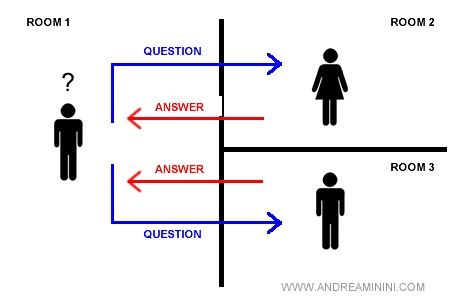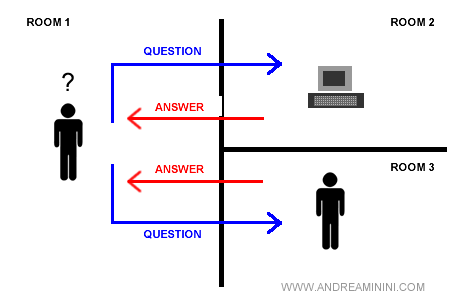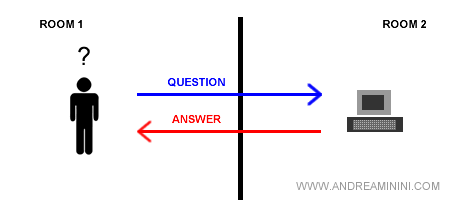Turing Test
The Turing test is one of the first attempts by man to measure the artificial intelligence of a computer. It was conceived by Alan Turing in 1950. The test is similar to a game even if its applications are very serious.
What is the Turing test?
The main purpose of the test is to determine if a machine can be called intelligent or not. It is one of the main tests of artificial intelligence ( Artificial Intelligence or A.I. )
How the Turing test works
In the original version of Alan Turing it is divided into two different phases.
The first phase of the test
In the first session three people participate: a man, a woman and an interviewer. The three people are in separate rooms and communicate with each other via a teletype.

The interviewer sends written questions to the other two people. He does not see them, therefore, he does not know if he is talking to a woman or a man.
The purpose of the questions is to understand which interlocutor is the man and which interlocutor is the woman.
Example. A typical question may be "do you have long or short hair?", "Wear a skirt or pants?".
Participants in the game receive the question and respond to the interviewer in writing, using the teleprinter.
The game seems to be very simple and the problem of quick solution. In reality it is not so because the participants in the game can also lie.
The two participants have different purposes.
- A participant is sincere. The first participant has the goal of facilitating identification by the interviewer, so he is sincere in his answers.
- A participant lies. The second participant, on the other hand, has the goal of making the interviewer's identification wrong, and therefore provides untruthful answers.
The interviewer does not know who is lying and who is sincere. He must be able to understand it for himself. At the end of the game the interviewer must decide who of the two participants is the man and the woman.
Repeating the game N times, the interviewer mistakes the sex of the participants for X times. Its error rate is X / N.

Example. After 100 reiterations of the game, the interviewer is wrong 25 times the sex of the two participants. Its failure rate X / N is 0.25 or 25%.
The second phase of the test
In the second phase of the test we replace one of the two participants with a computer. Now the interviewer must understand whether to answer is a man or a machine.

The process is always the same. The interviewer formulates questions to the participants via teletype and can not see them. He does not know if he's talking to two people or if one of them is a computer.
At the end of the game the interviewer must identify the participants based solely on their written answers.
The game repeats N times and the interviewer is wrong for Z times, obtaining a percentage error rate equal to Z / N.

Example. Over 100 reiterations of the game, 10 times the interviewer confuses the machine for a human. Its failure rate Z / N is equal to 0.10 or 10%.
When is the Turing Test passed?
If the percentage of error in the game in which the machine participates is similar or inferior to that of the game to identify the man and the woman, then the Turing Test is passed and the machine can be called intelligent.

Loebner Award. In 1991, Hugh Loebner launched a contest giving away a prize of one hundred thousand dollars to the first developer who is able to pass the Turing Test.
The simplified version of Turing test
There are different versions of the Turing Test. In the simplest one, the human interviewer communicates via teletype with another subject placed in another room. It could be a person or a computer. The machine must convince the interviewer that it's a human.

This simplified version of Turing test is the best known to the general public and the mass media, but it is also the least effective.
In the history of computer science, very simple and non-intelligent programs have been created, able to deceive a person into a realistic conversation, for a few minutes, but through tricks. These machines can not be called sentient.
Note. One of the first "non-intelligent" software to deceive man was the Eliza program, developed in 1965 by Joseph Weizenbaum. In the following decades many other similar software were developed, up to modern chatbots. These programs develop realistic but senseless dialogues.
